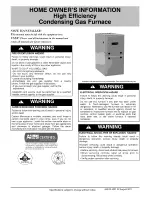
26
Line polarity must be observed when making field connections.
Line voltage connections can be made through either the right or
left side panel. The furnace is shipped configured for a left side
(right side for counterflows) electrical connection with the
junction box located inside the burner compartment.
To make electrical connections through the opposite side of the
furnace, the junction box must be relocated to the other side of
the burner compartment prior to making electrical connections.
To relocate the junction box, follow the steps shown in “Junction
Box Relocation.”
NOTE: Wire routing must not to interfere with circulator blower
operation, filter removal, or routine maintenance.
Junction Box Relocation
1. Remove the burner compartment door.
2. Remove and save the 2 screws securing the junction box to
the side panel.
3. Relocate junction box and associated plugs and grommets to
opposite side panel.
4. Secure with screws removed in Step 2.
Junction Box Relocation
To ensure proper unit grounding, the ground wire should run from
the furnace ground screw located inside the furnace junction box
all the way back to the electrical panel.
NOTE: Do not use gas piping as an electrical ground.
To confirm proper unit grounding, turn off the electrical power
and perform the following check.
1. Measure the resistance between the neutral (white)
connection and one of the burners.
2. Resistance should measure 10 ohms or less.
This furnace is equipped with a blower door interlock switch
which interrupts the unit voltage when the blower door is opened
for servicing.
NOTE: Do not defeat this switch.
24-Volt Thermostat Wiring
NOTE: Wire routing must not interfere with circulator blower
operation, filter removal or routine maintenance.
Low voltage connections can be made through either the right or
left side panel. Thermostat wiring entrance holes are located in
the blower compartment. Wire routing must not interfere with
circulator blower operation, filter removal or routine maintenance.
Refer to the following illustration for thermostat connections to
the integrated control module terminal strip.
Thermostat Diagram
This furnace is equipped with a 40 VA transformer to facilitate use
with most cooling equipment. Consult the wiring diagram located
on the blower compartment door for further details of 115-volt
and 24-volt wiring.
NOTE: To apply a single-stage heating thermostat, the
thermostat selector switch on the integrated control module must
be set on single-stage.
WFM19 Furnace with 2-Stage Condenser
Field Wiring
The WFM19 model furnaces may be used with a 2-stage outdoor
air conditioner. A 2-stage cooling/single-stage gas heat
thermostat is required, in addition to a field supplied relay. The
relay must have a 24 VAC coil and contacts rated for up to
1 horse power at 125 VAC.
1. Install the field supplied relay on the control mounting panel
near the furnace ignition control. The relay should be installed
so that the motor leads will reach the relay contact terminals.
2. Connect the Y2 (high-stage cool) thermostat terminal to 1 coil
terminal of the field supplied relay. Connect the other field
supplied relay coil terminal to the C terminal on the furnace
ignition control. Typical 18 AWG thermostat wire may be
used.
3. Connect the common terminal of the field supplied relay to
the LINE-H terminal on the furnace ignition control. Use
wiring having copper conductors only and a temperature
rating of at least 105°C.
4. Using the WFM19 airflow tables in this manual, determine the
motor speed tap needed to deliver the required high-stage
cooling airflow. Connect the selected motor speed tap to the
normally open terminal on the field supplied relay. Use wiring
having copper conductors only and a temperature rating of at
least 105°C.
5. See “Field Wiring for WFM19 Furnace with 2-Stage
Condenser” illustration.
A. Standard junction box location
B. Alternate junction box location
Goodman 56
Edges of sheet metal holes may be sharp. Use gloves as
a precaution when removing hole plugs.
WARNING
*
*
*
*
*
*
*
A
B
Goodman 60
HIGH VOLTAGE!
WARNING
To avoid the risk of injury, electrical shock
or death, the furnace must be electrically
grounded in accordance with local codes or
in their absence, with the latest edition of the
National Electric Code (NEC).
A. Heating room thermostat
B. Furnace
C. Heating and cooling room thermostat
D. Remote condensing unit
W
W
W
Y
Y
Y
C
C
R
R
R
G
G
W
Y
C
R
G
A
B
C
B
D
















































